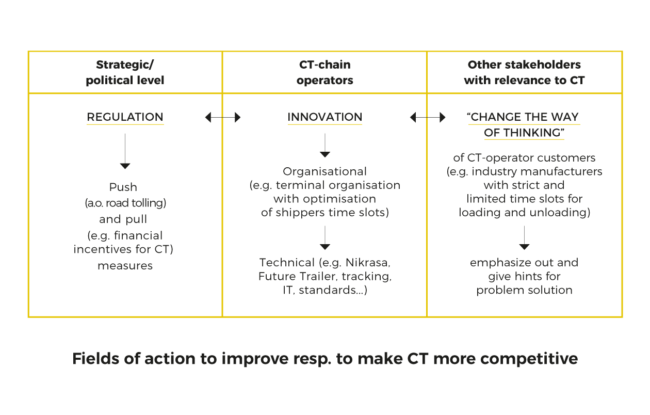This section summarizes conclusions and recommendations on advancing CT and accelerating low-carbon transport particularly in the sensitive areas of the Alpine Space. The recommendations are based on the outcomes of activities and discussions carried out by the project partners of the AlpInnoCT project.
Almost all recommendations address the strategic/political level as well as the CT operators. The third field of action according to the figure above, i.e. other stakeholders with relevance to CT, was integral part of discussions among project partners as well as in the Dialogue Events. For the two other fields of action, recommendations were derived by identifying gaps in existing policy instruments and defining key elements, concepts and technologies that could be introduced in future on a larger scale to facilitate and improve the use of CT.
The recommendations from the AlpInnoCT pilot cases are focused on concrete activities and their (quantitative) results to raise CT efficiency and productivity; the application of production industry know-how in CT is a new approach and includes analysis of existing strategies, policies and processes focusing on CT:
In summary and to overcome the hurdles to improve the modal shift from road to rail with CT in and through the Alps, it is also necessary to implement these approaches on a larger scale in the Alpine Space between different terminals and to show and evaluate the efficiency on a larger geographical scale and between different railway undertakings and transport operators. Stronger attention to more entrepreneurial aspects, especially of SMEs (small and medium enterprises) in the sector, has been recognized as very important as well.
The following policy recommendations are addressing issues at stake or areas for improvements that have been tackled, such as the needs to:
Improve and expand terminal infrastructure including the building of new terminals considering sustainability criteria and cooperation between stakeholders.
Generally upgrade rail infrastructure connecting CT nodes as a priority.
Improve the lobbying at European level, but also at national and regional levels to provide substantial direct measures such as subsidies and other financial incentives for CT to support an effective modal shift.
Better harmonize freight and passenger transport and prioritize freight transport at certain non-peak times.
Provide indirect measures to foster CT-related research and development to push smart IT-solutions and communication flows along the transport chain.
Policy-makers and stakeholders have been addressed by communication and awareness raising activities and through their participation in the Dialogue Events of AlpInnoCT. Thus, the project involved and took into consideration also the requirements of all levels of policy making through project partners and observers at European, national, regional and local level.
In conclusion, a continuous dialogue of different stakeholders on how to commonly foster CT in and through the Alps is important and should be exploited for policy making purposes and be capitalized in possible up-takes.



